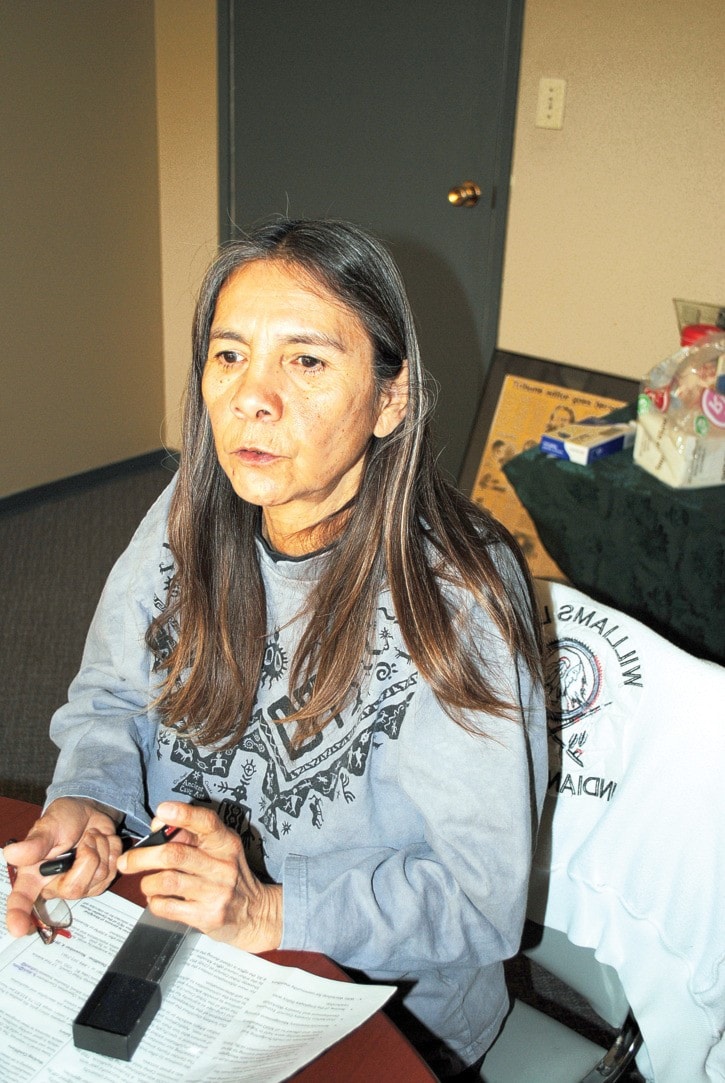If she’s able to spend time at a Farwell Canyon fish camp, Helen Sandy says her summer feels complete.
Since 1996, the Secwepemc woman from the Sugar Cane Reserve has been going there pretty steadily.
“Every now and then I miss out. The year before last I did because I had no transportation out there and no fishermen so I just stayed in town,” Sandy says.
Sandy first learned how to prepare and smoke salmon from Velva Tenale, who has had a fish camp at Farwell Canyon for years, and urged Sandy to learn.
Four years ago Sandy set up her own camp, and has her own process down to a science.
Holding out her arm, she demonstrates how she takes the fish, cuts the head off and breaks the back bone.
She then grabs the fish by the tail, shakes it, and the weight of the head pulls the innards out.
From there she cuts up to the belly and takes the blood line out and removes all the fins.
“Normally out there we’ll have a pot of soup on and what goes into that soup are the fish heads, the salmon eggs, and the fins. People eat it. I haven’t tried it yet. They say the eyes are the best.”
Then she cuts strips off the belly along the side that are about an inch and a half wide, opens them up, salts and peppers them, and places them in a roasting pan or a bowl.
Once the fins and belly have been removed, she cuts from the neck down as close to the bones as she can all the way down the tail. She then flips it over and all the way down the back.
“By the tail you cut on either side of the tail and break that bone out,” she says, adding experience has taught her how to fully utilize as much of the salmon as she can.
When she arrives at Farwell Canyon, Sandy makes a tent for herself with sticks and tarps, and prepares a fire for the smoking.
“I clear off the ground on the dry grass, go down to the beach and get sand and gravel and scatter it on the ground. Then I dig a fire pit a couple of feet deep, then I put rocks around, about a foot high, to make a fire pit. Over that I put a piece of metal.”
“I came home with about 150 dried fish and I sent in 40 for the freezer and another 20 fresh fish to can last time.”
One night she was in camp alone, and there were black bears and cougars coming around.
“Thank God I had a gun,” she says.
It is normally very hot when she’s at the camp, and because she cuts her salmon strips so thin, they dry in about three days.
“I have a steel knife that’s quite wide and a stone that I use to sharpen it. When you’re cutting salmon you have to sharpen it between the third and fifth salmon because it goes through scales and bones. I use a really sturdy heavy butcher knife to take off the head and fins. When I cut the belly I use a filleting knife.”
Peppering the salmon is a personal choice, she explains.
“I like the taste.”
When it comes to fuel, she uses choke cherry, maple, apple and cotton wood. First thing each morning she builds the smoke fire and leaves it to smoke all day long until it naturally dies down in the evening.
Aside from preparing and smoking the fish, Sandy also picks choke cherries and dries them.
The cherries start to ripen in early August, along with crab apple trees near the old log houses at the former ranch site at Farwell Canyon.
“There are choke cherries all over. There are some choke cherries across the creek that look like glazed cherries and the ones that are dark brown in colour,” she says.
Growing up at Sugar Cane, Sandy recalls as a small girl she was not allowed to go to Farwell Canyon because it was too dangerous.
Her mother, Anastasia Sandy, didn’t teach her children how to cut salmon.
The men on the reserve would take the boys and teenagers to the river to fish at night time.
Meanwhile, her mom had four galvanized tubs sitting in the backyard, waiting for their return when they’d dump sacks of fish in the water and cover the tubs with boards. Her mom would rise at 5 a.m. the next morning to gut and clean as many fish as she could, waking Sandy and her siblings at 7 a.m. to help.
Anastasia cut the fish in an “open book” style, where she chopped the heads off, cut up the belly line, and then went in close to the spine, breaking the bones and cutting it to the skin on both sides of the backbone.
“The backbone would stay on there, the belly bones would stay on there, and she’d cut by the spine and cut across along the skin and flip it open,” she says, opening both of her hands.
Sandy says the fish they ate in those days came from the Fraser River, not the Chilcotin River.
“I think the fish from the Chilcotin River are firm and less beat up. The salmon do go through the Fraser before they get to the Chilcotin River, so it’s the same fish, but the fact of the matter is when you catch them at Sheep Creek Bridge where our fishing grounds are, those salmon taste too mushy. They are harder to cut up.”
When she’s not preparing fish, or gathering hundreds of chokecherries from nearby bushes at the site, Sandy loves to take photographs.
Hundreds of her photos document the fish camp, the fishermen, the surroundings, and the visitors to her camp.
